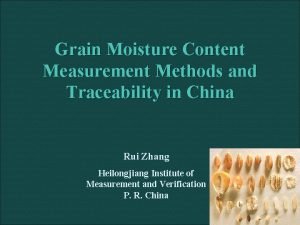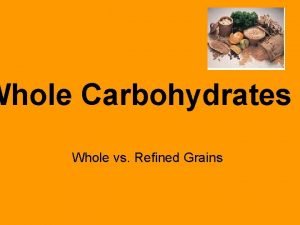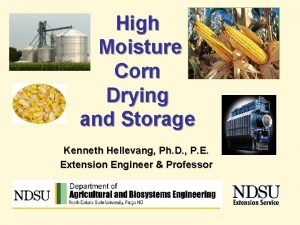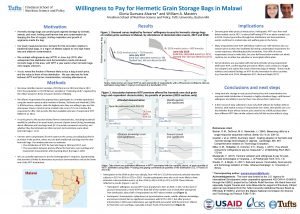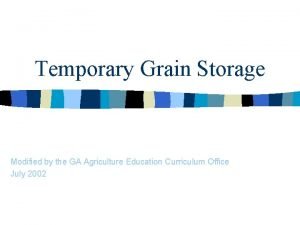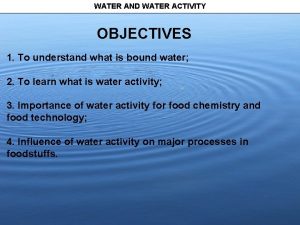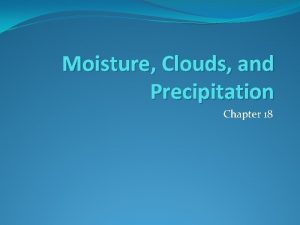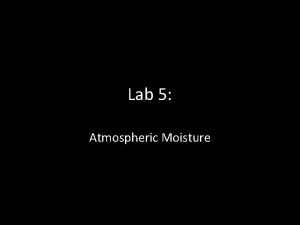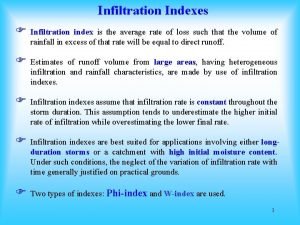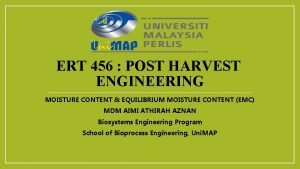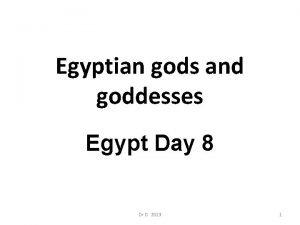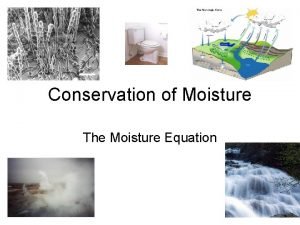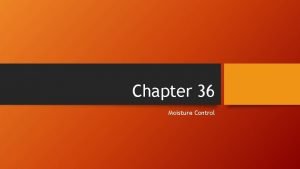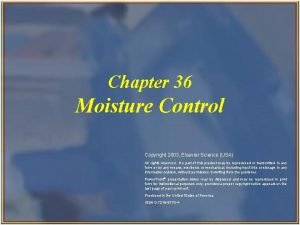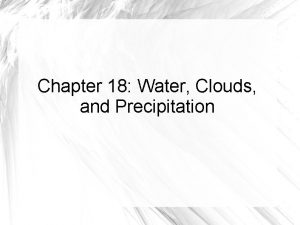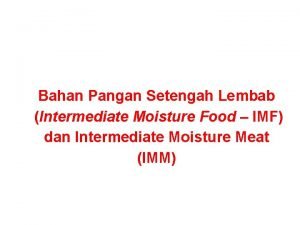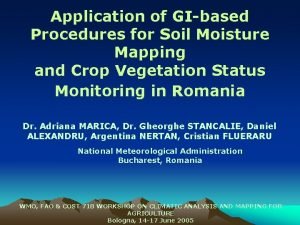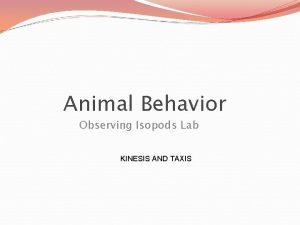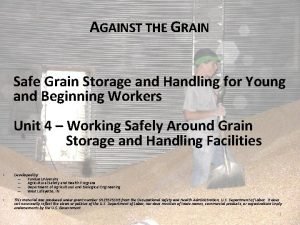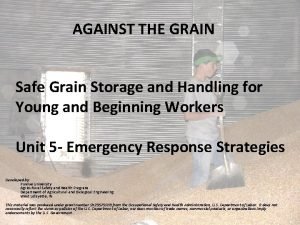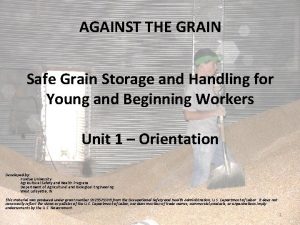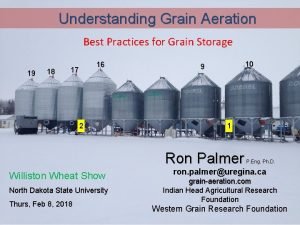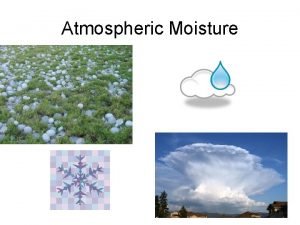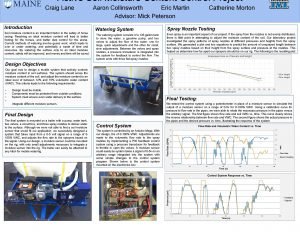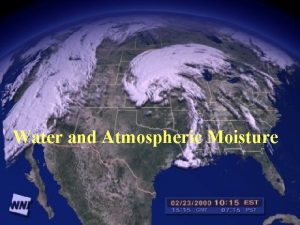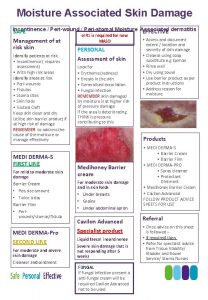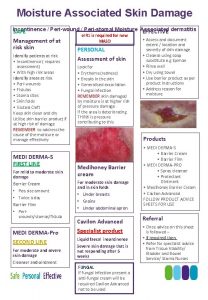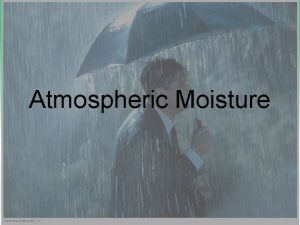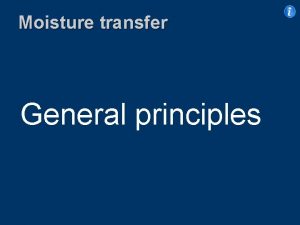Storage Systems Grain Storage v Moisture is the

















- Slides: 17

Storage Systems

Grain Storage v Moisture is the major factor involved in grain storage v Need to have dry feeds for bin or shed storage ü Small grains – whole: 12% moisture ü Corn – whole: 14% moisture ü Ground grains (or with >12% broken kernels): 11% moisture ** Note: grains will need to be drier if insects are a problem; also can fumigate q These values depend on humidity, temperature and air flow

Grain Storage q Higher moisture levels cause: ü ü ü Heating Caking Mold: • • Produce mycotoxins, cause reduced performance, poor feed efficiency, diarrhea, liver disease, infertility, abortion, poor immune functions These effects can be a problem for humans, some are carcinogenic

Grain Storage q Important molds found in grains ü Ergot, Clavicep purpurea • ü Aspergillus flavus, produce aflatoxin (a mycotoxin) • ü Very potent toxin that accumulates in the animal, especially in cereal grains (triticale), zero tolerance Extremely common mold, often causes deleterious effects in livestock including liver disease Fusarium fungus: produces zearalanone and vomitoxin (also known as DON = deoxynivalenol)

Grain Storage q Steps to prevent molds/mycotoxins ü ü ü Moisture test, reject any grain which is too wet or that you can’t dry (15% moisture or your known moisture content for your storage) Obtain a sample and analyze any suspect grains for mycotoxins Keep equipment clean and mold free – don’t contaminate clean grain!

Grain Storage q Amount of mold to tolerate: ü < 10% damage is probably safe ü 10 to 40% damage is risky ü >40% damage – absolutely not Do not feed to young, growing animals or to reproducing animals (toxins can kill the embryos)

Grain Storage – Cost Considerations q 2% reduction in price for each moisture point over permissible level Lower level of DM (don’t pay for water) ü Storage loss or cost of drying ü

Grain Storage v Alternatives (to dry grain) q q q Longer field drying Solar drying Preservatives ü ü ü q 0. 5% propionic acid – protects grains up to 24% moisture Microbial inoculants; seems to be effective Both also extend bunk life High moisture grain storage *** Actually, high moisture grains have superior feed value (feed efficiency)

High Moisture Grain q q 22 to 35% moisture As with silage need airtight structure for anaerobic fermentation n Coarsely grind, pack in air-tight silo for fermentation n n p. H dropped to 4 or less, stops bacteria growth and product preserved n q Can be stored whole, then rolled upon removal from silo increases palatability Faster fermentation ü ü More soluble nutrients Can expel oxygen with lower water content – acids concentrate faster

High Moisture Grain q Advantages ü ü ü Early harvest – reduce field loss; shattering, lodging, hail, bird, deer No artificial drying needed Bunker may be lower storage cost Corn: less risk of frost damage ** increased feed efficiency

High Moisture Grain q Disadvantage ü ü Grain must be stored immediately – does not allow much buying and selling Must be fed to livestock Must be stored air tight Handle more weight because of water

Grain Processing n Grains often processed prior to inclusion in feeds n Alters feeding characteristics in predictable ways

Limitation Factors of feedstuff § § § § § Density / Crude Fiber content Anti Nutritional content Essensial Amino Acid Digestibility Value Lipid content Ca : P balance Efect to carcass quality Palatability Price and avaiability

Limitation factors of AA content Feedstuff Ø Yellow corn Ø Sorghum Ø wheat Ø Soybean meal Ø Cotton meal Ø Coconut meal Ø Fish meal Ø MBM Ø Blood meal Ø Feather meal Ø Rice bran Ø Pollard 1 st Lys/Tryp Lys Met Lys Tryp Isoleu Met Lys 2 rd next Lys/Tryp Met/Threo Tryp Threo Met Threo Isoleu Lys Met Lys Isoleu Threo Isoleu

Feedstuff Limit Utilization Feedstuff Yellow corn Sorghum Rice bran Separated bran Tapioka starch Pollard Sago Wheat Animal fat Vegetable oil molasses LS 60 30 10 40 8 15 15 30 6 5 3 LG 60 30 15 40 10 15 15 40 6 5 3 L 60 30 40 40 10 40 25 50 6 5 5 BS 60 30 10 40 8 15 15 30 6 5 3 BF 60 30 10 40 10 15 15 30 6 5 3 PS 60 30 25 40 10 25 25 50 6 5 5

Feedstuff Limit Utilization Bahan Pakan Leucaena leaf meal Ca CO 3 Shell powder Skim milk Shrimp meal Ferm. Cassava manure Ferm. Bran manure Ferm. Garut beet manure Fermented cassava Hidr. Rumen biomass Caccao meal Worm Manure LS 5 5 2 2 5 10 10 5 5 5 LG 5 5 2 2 5 10 10 10 5 5 L 5 5 4 2 5 20 10 10 10 8 10 5 BS 5 5 1 2 5 10 10 5 5 5 BF 5 5 1 2 5 10 10 8 5 5 PS 5 5 2 2 5 10 10 5 5 -

Feedstuff Limit Utilization Feedstuff SBM Peanut meal Coconut meal Cotton meal Rubber seed meal Fish meal Feather meal Blood meal Meat meal Bone meal MBM Dried Snail LS 40 5 10 10 2 2 7 5 8 3 LG L 30 40 7, 5 25 15 25 5 10 15 15 8 10 5 5 2 2 7 7 5 5 8 10 3 3 BS BF PS 40 30 30 5 7, 5 10 15 15 15 2, 5 5 10 15 15 10 10 10 5 5 2 2 7 7 7 5 5 5 8 8 8 3 3 3
 Grain moisture content measurement
Grain moisture content measurement What are refined grains
What are refined grains High moisture corn storage
High moisture corn storage Hermetic grain storage bags
Hermetic grain storage bags Temporary grain storage
Temporary grain storage Moisture sorption isotherm
Moisture sorption isotherm A picture of precipitation
A picture of precipitation Lab 5 atmospheric moisture
Lab 5 atmospheric moisture Antecedent moisture condition
Antecedent moisture condition Equilibrium moisture content definition
Equilibrium moisture content definition Atum
Atum Moisture equation
Moisture equation Moisture control dental
Moisture control dental Chapter 36 moisture control
Chapter 36 moisture control Frontal wedging
Frontal wedging Danbunama
Danbunama Moisture mapping software
Moisture mapping software Kinesis vs taxis
Kinesis vs taxis
